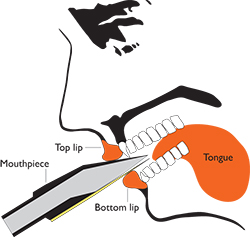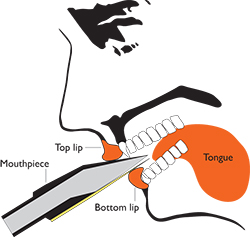If you've never played a saxophone - or a similar instrument, such as a clarinet - you'll find it tricky to start with. Working the reed of a saxophone requires developed lip muscles to properly compress the reed. You'll need to be able to surround the reed and mouthpiece with a ring of muscle. Just like the other muscles in your body, you'll need to develop your lip muscles before they'll be up for the work. Your sax is going to sound 'interesting' for the first few weeks as your lip muscles get used to it. I call it 'air time' The more you practice (ie the more time you spend putting air through your horn),the sooner the neighbours will stop banging on the wall...And this muscle development is best obtained through regular (daily if possible) short spells of practice, rather than an hour's frantic session immediately before a lesson! Apart from anything else, your lips won't make it through an hour for a good while!
Embouchure (French) essentially means the positioning and shape of your mouth. There is no real "correct" saxophone embouchure - merely one that works for each individual and produces a sound that the player is happy with. The diagrams below show the three most common embouchures:

Pic. 1 shows a saxophone embouchure in which the lower lip does not cover over the lower teeth

Pic 2 shows the bottom lip forming a cushion between the lower teeth and the reed

Pic 3 shows the top lip also forming a cushion between the top teeth and the top of the mouthpiece
Below are some extracts from the Ben Davis' book, (published by Henri Selmer) which is now sadly out of print. This was quite controvertial at the time as the 'no-lip over teeth' saxophone embouchure (shown in the first diagram above) was quite revolutionary.
"There are three types of embouchure, two of which, in my opinion, are wrong. I will explain what they are and why I think they are wrong as we go along. First, the right embouchure, which I call, for the sake of differentiation, the "new" embouchure. Open the mouth in the shape of a small o; keep the lips close to, but not drawn in over the teeth. Then insert the mouthpiece. Rest the lower lip against the lower teeth; then lower the reed onto the rim of the lip, so that the inside of the lip forms a cushion between the teeth and the lip. Do not draw the lip in over the teeth. It must just rest against them so that only the thinnest part of the fleshy inside lip is pushed over the teeth when the mouthpiece is in playing position. The rest of the lower lip will then form a sort of support for that part of the reed which is immediately outside the mouth. Next, lower the upper teeth on to the mouthpiece with the lightest of pressure. The upper lip must not come between the teeth and the mouthpiece in any way. Finally close the lips round the sides of the mouthpiece so that no air can escape from the sides of the mouth. Don't, however, exert so much pressure that the corners of the mouth are tensed. Neither pout the lips. You have now the "new" saxophone embouchure. It is illustrated, slightly exaggerated in order to make it clearer, in pic 1.
Now for the other two embouchures, an understanding of which will help you to appreciate the more subtle points of the correct way. The 'old' saxophone embouchure differs from that described here in that the lower lip is drawn in over the lower teeth, making a thick and heavy pad of flesh for the reed to rest on. This is extremely tiring for the lip, and the embouchure soon weakens, with consequent lack of control over the reed and resultant poorness of tone and harsh low notes. The 'old' sax embouchure is shown in pic 2.
The third method is that known as the 'clarinet' embouchure, which consists of drawing both the upper and lower lips over the teeth (pic 3). This is considered wrong for the saxophone because the tonal quality of the clarinet is dependent on blowing a limited amount of breath into it in a certain manner - the reason it has a different shaped tone chamber and a closer lay. etc, etc..."
Most players would consider that none of these is wrong - they merely each suit different saxophone players and styles. Whatever style a player uses when starting out, it is possible to change embouchure, although as with anything it will take some time to get used to. Although these pictures are a good guide, it's obviously far more beneficial to be physically present with the student.
Personally, I suggest you experiment with all three methods and adopt the one you think works the best for you, both for comfort and sound.